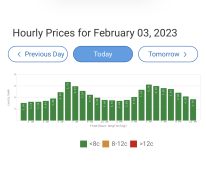That is exactly what I did. What size batteries and how big was the Enphase GT solar system? One thing I like about using the generator port for AC coupled solar is the production shows up on the SolArk. Did you add any DC coupled solar to the system?
Not my system, but yes, panels were added to supply 15kW of non-propritary batteries. Since Sol-Arc covers the charging and switch over from grid to off grid, that saved a few components.
I'm NOT a fan of integrated/all in one units. Anyone that waited a month to get a service call, then waited 6 weeks to 6 months for a repair/replacmemt or warrenty decision knows why I don't care for integrated systems or non-modular, propritary systems.
The maker doesn't support your system anymore, they give you a pro-rated warrenty that's next to nothing, and it's often only good if you buy the model they are selling at the time...
AND you get stuck with bills installing the new unit (to code)... Thanks for wasting my time and money situations.
I'm off grid, modular, but I have the space for modular components spread out. Something fails it was so cheap I usually have spares on the shelf, so it's a swap out and I'm not blacked out while waiting for a warrenty decision.
Since DIY is 1/4 to 1/2 the cost, there is room in the budget for spares, and component prices aren't marked up 300% by the installer.
This guy HAD to have grid tie, that means code inspector, and that means something with all the certifications. He also didn't have a lot of space, so a combined unit saved the day considering the requirements and restrictions.
I have five homes, four 'cabins' (tiny home/yard barns around a lake), and three businesses hooked to a mini grid.
As you might imagine, most people want flush toilets, lights that work on a switch, and a thermostat on the wall. It's mandatory if you want to attract a female...
So we centered the solar field, slapped panels on all roofs, and did the DC coupled thing (Main DC Buss) into the businesses.
We do small AC coupled, hang a DC inverter on the main Buss, then use a smaller grid tie/AC coupled inverter out at whatever satellite spot we need 120/240 VAC.
In 2020 I tried to large scale AC couple, and it was a $60,000 disaster. Different manufacturers use different protocols, the AC frequency shift got out of hand and things randomly shut down, etc.
Then along cones Sol-Ark a couple years later and solves all those issues... $60,000 would have bought a crap load of 15k inverters at about $8,000 a piece, and up to 9 will AC couple without a master controller. (See SMA/Sunny Island)
Now that Sol-Ark has done it, the price will come down, different manufacturers will reproduce it (providing it keeps selling like hot cakes), and it's stupid high efficiency (unlike big transformer systems) so other than being propritary (stuck with one company) it's a serious breakthrough for those of us wanting to expand.
I can't sell what I have as a home game, everyone has different circumstances and budgets, levels of ability/education...
I just found it funny the whole house Sol-Ark 15k and more than 4 times the non-propritary battery came in less money than the Enphase with it's limited size, propritary battery.
Can't tell you about the Enphase, wasn't my end of things, I was there to check/test batteries and make sure no one did anything stupid with the high amp cables/terminals.
While we were there with a boom truck, we replaced 3 Endphase micro inverters that have failed, it's like that on every job with Enphase micros.



